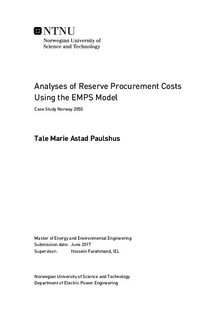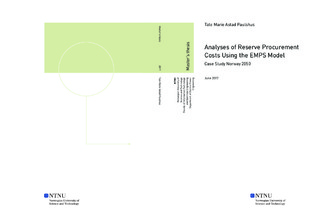| dc.description.abstract | Europe is moving towards an energy transition including increasing the share of power produced from renewable energy sources and an increase of the CO2 price in order to reduce the climate changes and curtail the damaged caused by emissions. A shift towards a larger share of power generation from renewable sources results in greater variations in power outputs and thus a greater need for reserve power to balance the power system. The Norwegian hydro power holds characteristics that make it fit to provide reserve power and is the motivation for the master project. The goal of the master project is to quantify and perform sensitivity analysis on reserve procurement costs in a simplified model of the Norwegian power system using the EMPS model as a modelling- and simulation tool for scenarios representing Norway and Europe in 2050. The EMPS model simulates the power market and handles hydro power in a detailed matter, including water value calculations to determine the value of water in reservoirs.
The master thesis is divided into three subsections: The first section present the theory, including modelling and solution principles, optimization problems, cost of reserves, setting reserve requirements, the project used to extract data for the scenarios, the e-Highway2050 project, and a presentation of the EMPS model.
The second subsections review the process of developing the scenarios by presenting the initial data set, the assumptions, the implementation process and the modified data sets, the scenarios.
The analysis takes part in the third subsection. The analysis is assembled by two cases, Case I and Case II. Case I has the objective to quantify the theoretical reserve requirements for the scenarios and to quantify the cost of introducing the reserve requirements in the three scenarios by the dual value of the reserve restriction included in the optimization problem, the difference in socioeconomic surplus and the effect on the power prices. The simulations showed that Norway has a large surplus of power and hence low prices of power in all of the scenarios. Introducing the reserve requirements in the data sets had a price and a cost, represented by the values listed, for all scenarios, but differs in extent. Case II has the objective to perform sensitivity analysis on the scenarios by investigating the trends of reserve prices (dual values), total socioeconomic surplus and power prices when increasing the reserve requirements with 2, 3,4 and 10 of the theoretical reserve requirements calculated in Case I to be able to handle dimension fault in the Norwegian power system. The findings in all of the scenarios coincided: The reserve prices increases with increasing reserve requirements, the difference in socioeconomic surplus increased with increased reserve requirements, the power prices in the time periods with initially high power prices were increased and the time period with prices near zero decreased with increasing reserve requirements. | |

